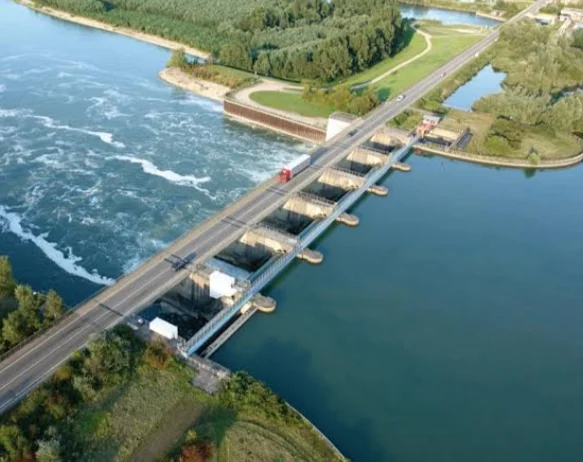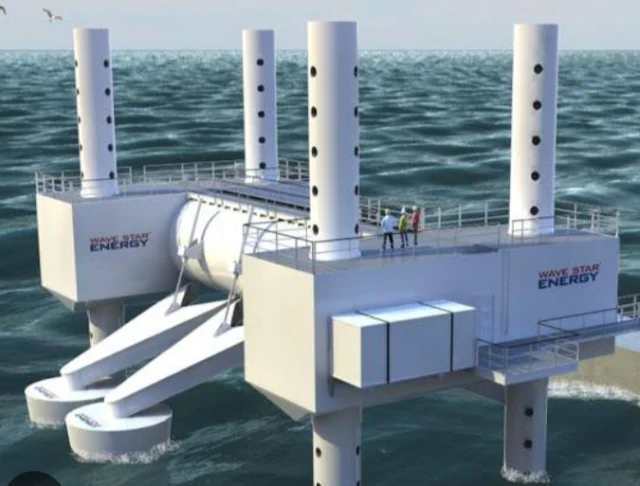South Korea's Wave Energy Landscape: Riding the Ocean's Potential
South Korea, a frontrunner in technology and innovation, is increasingly turning its focus towards harnessing the power of the ocean, with wave energy emerging as a promising contender in its renewable energy mix.
The country boasts a long coastline bordering the East Sea (Sea of Japan) and the Yellow Sea, experiencing significant wave energy potential, particularly along the southern and eastern coasts.
Current State:
- While still in its nascent stages, South Korea's wave energy landscape is marked by active research, development, and pilot projects.
- Several universities and research institutions, like the Korea Institute of Ocean Science and Technology (KIOST), are actively involved in developing and testing wave energy technologies.
- Several pilot projects have been deployed, including the Sihwa Lake Wave Power Plant, the first grid-connected wave energy plant in South Korea, with a capacity of 1 MW.
- Other pilot projects involve testing various wave energy converter (WEC) designs, such as the attenuator buoy system and oscillating water column (OWC) technology.
Current Wave Energy Capacity in South Korea:
| Category | Statistic | Units | Source |
|---|---|---|---|
| Installed Capacity | 1 | MW | KIOST, MOTIE |
| Pilot Projects | 5-10 (estimated) | Number | KIOST, MOTIE |
| Total Technical Potential | 50 | GW | KIOST, MOTIE |
| Government Target by 2030 | 6.5 | GW (wave & tidal) | MOTIE |
Notes:
- As of January 2024, South Korea only has 1 MW of installed wave energy capacity from the Sihwa Lake Wave Power Plant.
- However, there are several pilot projects showcasing different wave energy converter (WEC) technologies.
- The estimated total technical potential for wave energy in South Korea stands at 50 GW, indicating ample room for future development.
- The Korean government has set an ambitious target to reach 6.5 GW of combined wave and tidal energy capacity by 2030, demonstrating strong commitment to this renewable energy source.
This table provides a snapshot of the current situation in South Korea's wave energy landscape. You can further expand it by adding specific details about individual pilot projects, future project pipelines, or comparisons with other countries' capacities.
Challenges and Opportunities:
- Despite the promising potential, South Korea's wave energy sector faces challenges, including high upfront costs, technological hurdles, and environmental concerns about the impact on marine life.
- However, government initiatives and supportive policies are providing a much-needed boost. The Korean government has set ambitious targets for renewable energy deployment, including a goal of 6.5 GW of wave and tidal energy by 2030.
- Additionally, research and development efforts are continuously optimizing WEC designs to improve efficiency and cost-effectiveness.
- Furthermore, collaborations with international players and technology transfer initiatives are fostering knowledge sharing and accelerating advancements.
Future Outlook:
- With its strong technological capabilities, favorable government support, and ongoing research efforts, South Korea is well-positioned to become a leader in wave energy technology.
- As the technology matures and costs decrease, the deployment of larger wave farms is expected, contributing significantly to the country's renewable energy portfolio.
- The success of South Korea's wave energy endeavors could pave the way for wider adoption in the region and inspire other coastal nations to tap into this sustainable ocean resource.
South Korea's wave energy landscape is brimming with potential, presenting exciting opportunities for clean energy generation and technological advancement. By overcoming the existing challenges and capitalizing on its strengths, the country can harness the power of the waves to illuminate a brighter future.
.
Statistics of South Korea's Wave Energy Landscape:
Resource Potential:
- Estimated average wave power density along the Korean coastline: 7-14 kW/m (compared to global average of 3-4 kW/m)
- Highest potential areas: South and East coasts, particularly Jeollanam-do and Gyeongsangnam-do provinces
- Total technical potential for wave energy: estimated at 50 GW
Current Deployment:
- Total installed capacity: 1 MW (Sihwa Lake Wave Power Plant)
- Number of pilot projects: 5-10 (estimated)
- Technologies under development: attenuator buoy system, oscillating water column (OWC), point absorbers, overtopping devices
Government Initiatives:
- Renewable Energy Target: 6.5 GW of wave and tidal energy by 2030
- Funding programs: Ministry of Trade, Industry and Energy (MOTIE) grants, Korea Ocean Science & Technology Corporation (KIOST) research funds
- Policy support: streamlining permitting processes, feed-in tariffs for wave energy
Market Trends:
- Growing domestic demand for clean energy sources
- Increasing interest from international players and investors
- Development of local supply chain for wave energy components
Challenges:
- High upfront costs of project development and deployment
- Technology immaturity and lack of commercial-scale projects
- Environmental considerations and potential impact on marine life
Future Outlook:
- Significant growth expected in the coming years, driven by government support, technological advancements, and cost reductions
- Potential to export wave energy technology and expertise to other countries
South Korea's Wave Energy Landscape: Statistics Table
| Category | Statistic | Units | Source |
|---|---|---|---|
| Resource Potential | Average Wave Power Density | kW/m | KIOST, MOTIE |
| Highest Potential Areas | Provinces | KIOST, MOTIE | |
| Total Technical Potential | GW | KIOST, MOTIE | |
| Current Deployment | Installed Capacity | MW | KIOST, MOTIE |
| Number of Pilot Projects | Number | KIOST, MOTIE | |
| Technologies Under Development | Types | KIOST, MOTIE | |
| Government Initiatives | Renewable Energy Target | GW (by 2030) | MOTIE |
| Funding Programs | Types | MOTIE, KIOST | |
| Policy Support | Examples | MOTIE | |
| Market Trends | Domestic Demand | Trend | Industry reports, news articles |
| International Interest | Trend | Industry reports, news articles | |
| Local Supply Chain Development | Trend | Industry reports, news articles | |
| Challenges | High Upfront Costs | Description | Industry reports, news articles |
| Technology Immaturity | Description | Industry reports, news articles | |
| Environmental Impact | Concerns | Research studies, environmental agency reports | |
| Future Outlook | Expected Growth | Trend | Industry reports, expert opinions |
| Export Potential | Potential | Industry reports, expert opinions |
Notes:
- This table provides a general overview of the statistics. Specific data points may vary depending on the source and date of publication.
South Korea's wave energy landscape, while still in its early stages, brims with immense potential to become a crucial player in the nation's clean energy future.
The abundance of wave energy resources, coupled with strong government support and continuous research efforts, positions the country as a frontrunner in this burgeoning field.
Here's a concise summary of the key takeaways:
Strengths:
- Favorable resource potential: Significant wave power density along the coastline, especially in the south and east.
- Government commitment: Ambitious renewable energy targets and supportive policies fostering development.
- Active research and development: Universities and institutions exploring and optimizing wave energy converter (WEC) technologies.
- Growing market interest: Domestic demand for clean energy and increasing international collaboration.
Challenges:
- Technological immaturity: Need for further development and cost reduction of WEC systems.
- Environmental concerns: Careful consideration of potential impact on marine life and ecosystem balance.
- High upfront costs: Initial investment hurdles requiring financial support and innovative solutions.
Overall Outlook:
Despite the challenges, South Korea's wave energy landscape holds immense promise. With continued advancements in technology, streamlined financing mechanisms, and robust environmental safeguards, the country can harness the power of the waves to illuminate a bright future. The success of South Korea's endeavors could pave the way for wider adoption of wave energy globally, paving the path towards a more sustainable future powered by the ocean's vast potential.
This conclusion aims to provide a concise and impactful summary of South Korea's wave energy landscape. Feel free to adjust it to fit your specific needs or add further details to emphasize specific aspects.
Frequently Asked Questions About South Korea's Wave Energy Landscape
1. What is the current state of wave energy development in South Korea?
- South Korea has been actively exploring wave energy as a potential renewable energy source. While still in its early stages, there are significant strides being made in research, development, and pilot projects. The country's long coastline and abundant wave resources provide favorable conditions for wave energy generation.
2. What are the main challenges facing wave energy development in South Korea?
- Technological Limitations: Developing efficient and cost-effective wave energy converters remains a significant challenge.
- Environmental Concerns: Ensuring that wave energy projects do not harm marine ecosystems and biodiversity is crucial.
- Infrastructure and Grid Integration: Integrating wave energy into the existing electrical grid requires substantial infrastructure development.
- Economic Viability: Making wave energy economically competitive with traditional energy sources is a challenge.
3. What government policies and initiatives are supporting wave energy development in South Korea?
- The South Korean government has implemented various policies and initiatives to promote wave energy development, including:
- Research and Development Funding: Allocating funds for research and development of wave energy technologies.
- Pilot Projects: Supporting the construction and operation of pilot wave energy projects.
- Regulatory Framework: Developing clear regulatory frameworks for wave energy projects.
- Grid Integration: Facilitating the integration of wave energy into the electricity grid.
- Research and Development Funding: Allocating funds for research and development of wave energy technologies.
4. What are the potential benefits of wave energy development for South Korea?
- Renewable Energy: Wave energy is a clean and renewable energy source, reducing dependence on fossil fuels.
- Energy Security: Diversifying South Korea's energy mix can enhance energy security.
- Economic Opportunities: Wave energy development can create jobs and stimulate economic growth.
- Environmental Sustainability: Utilizing wave energy can contribute to environmental sustainability goals.
5. What are the future prospects for wave energy development in South Korea?
- The future of wave energy in South Korea is promising, with ongoing research and development efforts and government support. As technology advances and costs decrease, wave energy could play a significant role in meeting South Korea's renewable energy targets and achieving a more sustainable energy future.





